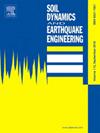Performance assessment of wind turbines in near-fault mountain regions subjected to physics-based simulated earthquake ground motions
IF 4.2
2区 工程技术
Q1 ENGINEERING, GEOLOGICAL
引用次数: 0
Abstract
In recent decades, wind turbines (WTs) have experienced unprecedented growth, and their increased installations in mountainous regions has significantly elevated the associated seismic risk. However, the understanding of seismic wave propagation and ground motion attenuations, particularly considering source-path-site effects, remains limited, becoming a key bottleneck in the seismic design of WTs. To address this, this paper assesses the seismic performance of WTs by analyzing the combined effects of seismic source characteristics, wave propagation paths, and local site conditions, and proposes a novel method for assess site effects on WTs in mountainous regions using scenario-based earthquake simulations. In the methodology, the frequency-wavenumber (FK) method is employed for the semi-analytical solution of deep crustal Green's functions, the spectral element (SE) method for efficient large-scale wave field simulations, and the finite element (FE) method for detailed structural modeling of WT responses. The resulting FK-SE-FE approach enables a full-process physics-based simulation from fault rupture to the structural response. Using the Jishishan MS6.2 earthquake as a case study, near-fault ground motions are synthesized to evaluate the influence of mountainous' terrain on the seismic response of WTs. Results indicate that the presence of the mountain during seismic wave propagation significantly increased the overall seismic response of the structure, with the tower-top displacement of the mountain-top WT being amplified by up to 2.56 times compared to the mountain base. Additionally, the continuous ridge effect led to an increased peak ground acceleration at the mountain base, but the overall amplification effect is more pronounced at the mountain top. These findings provide valuable insights for enhancing seismic design codes and developing risk mitigation strategies for WTs in complex terrains.
求助全文
约1分钟内获得全文
求助全文
来源期刊

Soil Dynamics and Earthquake Engineering
工程技术-地球科学综合
CiteScore
7.50
自引率
15.00%
发文量
446
审稿时长
8 months
期刊介绍:
The journal aims to encourage and enhance the role of mechanics and other disciplines as they relate to earthquake engineering by providing opportunities for the publication of the work of applied mathematicians, engineers and other applied scientists involved in solving problems closely related to the field of earthquake engineering and geotechnical earthquake engineering.
Emphasis is placed on new concepts and techniques, but case histories will also be published if they enhance the presentation and understanding of new technical concepts.
 求助内容:
求助内容: 应助结果提醒方式:
应助结果提醒方式:


